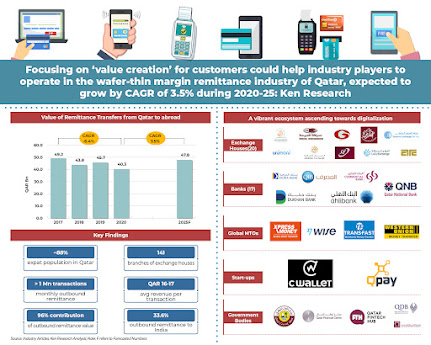- The Saudi Arabia
Remittance market is anticipated to grow at a CAGR of 2.8% during the
forecast period FY’20-FY’25.
- Growth of digital
payments solutions, along with rising fintech ecosystem are further
expected to give a boost to numerous entities that facilitate online
payments in the country.
- Opening of the
market to allow foreign MTOs will encourage entry of new players in the
oligopolistic remittance market
Saudi Arabia is one of the most
economically prosperous country in Asia and hence is a prominent emigration
destination to a many South Asian countries. Of the current population of 33
Million, more than 37% of population comprises of expats with India, Pakistan,
Nepal, Philippines, Bangladesh, Sri Lanka and Egypt being key source countries.
This results in a high contribution of outbound remittance in the industry as
the expats send money to their home country periodically.
Saudi
Arabia International Remittance Market Future Outlook
Due to increased focus on hiring Saudi nationals at higher level posts, more and more people are looking to move from Saudi Arabia. This led to a decline in the remittance industry size by value. However post-COVID the scenario has reversed due to higher propensity to save. Until 2019, the foreign MTOs were not allowed to set up business independently. But based on G20 National Remittance Plan, Saudi Arabia has opened the markets for foreign MTOs which will boost the industry growth.
How is the
competitive landscape in International Remittance Industry of Saudi Arabia?
The Saudi Arabian Remittance
market is dominated by major 7-8 which are providing remittance services from a
very long back. A very high amount of capital would be required to make
any position in the oligopoly remittance market of Saudi Arabia. More than 95%
of the remittance market is hold by 8 firms and the competition has been
growing largely since the increase in penetration of digital channels. Entry of
STC pay has gained a substantial market share since it begin their operations
and all other banks are now focusing on strengthening their digital channels.
Request for Free Sample Report @ https://www.kenresearch.com/sample-report.php?Frmdetails=NDg0NzMz
In Saudi Arabia, foreign MTOs
were not allowed to open their branches and providing remittance services
independently in the Kingdom. Since 2019, the plan have been introduced but
there are many rules and regulations which are to be followed for the foreign
money exchanges. The paid up capital has not been standardized for the foreign
players and it is to the discretion of Saudi Central Bank SAMA. This means that
the entry barriers are high for the remittance industry in the Kingdom.
What is the
future takeaway for industry players?
Given the backdrop of increase in
volume and value of outbound international remittance transactions, analysts at
Ken Research expect a growth of 4.5% during 2020-21 and CAGR of 2.8% during
2020-25F. During this period, value of transactions is expected to peak in 2025
which will be driven by the opening of the market for foreign MTOs and growing
adoption of digital solutions. Analysts at Ken Research further expect that
digitalization of services and corresponding marketing campaigns are expected
to drive the revenue of remittance industry at a CAGR of 3.1% during 2020-25F
Key Topics
Covered in the Report
·
Market
share of Exchange Houses Saudi Arabia
·
Overview of
International Remittance Industry in Saudi Arabia (Statistics on Corridor wise
Transaction volume and value)
·
Industry
segmentation (By Type of Transfers, Corridor wise)
·
Cross
Comparison of Major players on Operational and Financial Parameters (December
2020)
·
Company Profile
of Major Players (Overview, Products and Services, USP, Business Strategies,
Branch wise Operational Performance, Cumulative Financial Performance, Recent
Developments)
·
Growth
Drivers and Challenges to Saudi Arabia International Remittance Industry
·
Industry
trends and developments
·
Risk factors
in the industry
·
Rules and
Regulations by Government Bodies
·
Impact of
COVID-19 and Future Outlook of Industry
Related
Reports:
Follow Us
LinkedIn
| Instagram | Facebook | Twitter | YouTube
Contact Us:-
Ken
Research
Ankur
Gupta, Head Marketing & Communications


